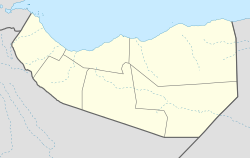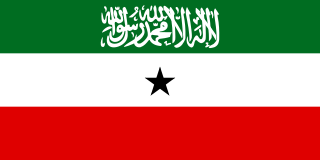
Somaliland, officially the Republic of Somaliland, is an unrecognised state in the Horn of Africa, recognised internationally as de jure part of Somalia. It is located in the southern coast of the Gulf of Aden and bordered by Djibouti to the northwest, Ethiopia to the south and west, and Somalia to the east. Its claimed territory has an area of 176,120 square kilometres (68,000 sq mi), with approximately 5.7 million residents as of 2021. The capital and largest city is Hargeisa. The Government of Somaliland regards itself as the successor state to British Somaliland, which, as the briefly independent State of Somaliland, united from 1960 to 1991 with the Trust Territory of Somaliland to form the Somali Republic.

Sanag is an administrative region (gobol) in north eastern Somaliland. Sanaag has a long coastline facing the Gulf of Aden to the north, and is bordered by the region of Sahil to the west, Sool to the south and Somalia to the east. The region is disputed by the self-declared Republic of Somaliland and Puntland, a Federal Member State of Somalia. Its capital city is Erigavo. Sanaag is the largest region of Somaliland, accounting for 35% of Somaliland's total land area.
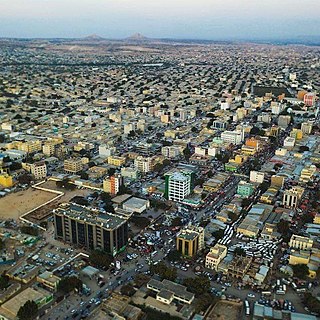
Hargeisa is the capital and largest city of the self-declared Republic of Somaliland, a de facto sovereign state in the Horn of Africa, still considered internationally to be part of Somalia. It is also the regional capital of the Maroodi Jeex province of Somaliland.
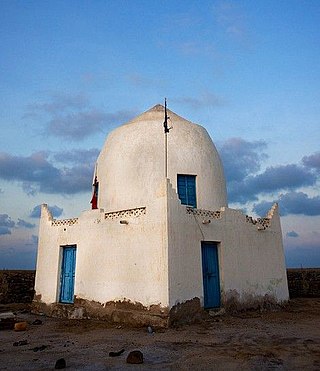
Zeila, also known as Zaila or Zayla, is a historical port town in the western Awdal region of Somaliland.

Culture of Somaliland encompasses a wide range of Somali activity and Islamic structures that give Somaliland a rich cultural and historical heritage. Nomadic and Arab Islamic cultural significance have also played a key role in Somaliland's cultural history.
The Jeberti are a Muslim clan inhabiting the Horn of Africa, mainly Somalia, Ethiopia, Eritrea, Yemen and Oman.

Aw-Barkhadle is a town located near Hargeisa in modern-day Somaliland. It was part of the Muslim empires in the Horn of Africa during the middle ages and served as the capital of the Adal Sultanate. It was also the burial place for many of the local leaders including the rulers of the Walashma dynasty that governed the Ifat and Adal Sultanate and kingdoms. Prior to that, it was a very important pre-Islamic center. The town is wholly dominated by the ciidagale and Habr Yunis isaxaaq carre. Both belongs to the Garhajis clan.
El Afweyn is a town in the Sanaag region of Somaliland.

Heis is a historic coastal town located in the Sanaag region of Somaliland. The town was important for trade and communication with the Somali interior and was used to export frankincense to Arabia.

Abasa is an ancient town in the northwestern Awdal region of Somaliland.

Amud or Amoud is an ancient, ruined town in the Awdal region of Somaliland. Named after its patron Saint Amud it was a center of activity during the Golden Age of the Adal Kingdom. The archaeological site is situated 1,000 metres (3,300 ft) above sea level, around 10 km southeast of the regional capital Borama.

Somali mythology covers the beliefs, myths, legends and folk tales circulating in Somali society that were passed down to new generations in a timeline spanning several millennia in Somalia Somaliland and Djibouti dating back 6000 years ago. Many of the things that constitute monotheistic Somali mythology today are traditions whose accuracy have faded away with time or have been gentrified considerably with the coming of Islam to the Horn of Africa.

Somali architecture is the engineering and designing of multiple different construction types such as stone cities, castles, citadels, fortresses, mosques, temples, aqueducts, lighthouses, towers and tombs during the ancient, medieval and early modern periods in Somalia and other regions inhabited by Somalis, as well as the fusion of Somalo-Islamic architecture with Western designs in contemporary times.
The predominant religion in Somalia is Islam, with tiny minorities of Christians, traditional African religions and others.
Tourism in Somalia is regulated by the Federal Government of Somalia's Ministry of Tourism. The industry was traditionally noted for its numerous historical sites, beaches, waterfalls, mountain ranges and national parks. After the start of the civil war in the early 1990s, the Tourism Ministry shut down operations. It was re-established in the 2000s, and once again oversees the national tourist industry. The Mogadishu-based Somali Tourism Association (SOMTA) provides on-the-ground consulting services.

Somali nationalism is centered on uniting the Somali people who share a common language, religion, culture and ethnicity, and as such constitute a nation unto themselves. The ideology's earliest manifestations in the medieval era are traced to the Adalites whilst in the contemporary era its often traced back to SYL, the first Somali nationalist political organization to be formed was the Somali National League (SNL), established in 1935 in the former British Somaliland protectorate. In the country's northeastern, central and southern regions, the similarly-oriented Somali Youth Club (SYC) was founded in 1943 in Italian Somaliland, just prior to the trusteeship period. The SYC was later renamed the Somali Youth League (SYL) in 1947. It became the most influential political party in the early years of post-independence Somalia. The Somali guerilla militia Al-Shabab is noteworthy for incorporating Somali nationalism into its Islamist ideology.
Yusuf bin Ahmad al-Kawneyn, popularly known as Aw Barkhadle or Yusuf Al Kownayn, was an Islamic scholar and traveler based in Zeila. Based on reference to Yusuf Al Kawneyn in the Harar manuscripts, Dr. Enrico Cerulli.

Sada Mire is a Swedish-Somali archaeologist, art historian and presenter from the Arap clan, who is currently a professor of Heritage Studies at University College London. She is a public intellectual and heritage activist who has argued that cultural heritage is a basic human need in her 2014 TEDxEuston talk. In 2017, Hay Festival of Literature and the Arts selected Mire as one of their 30 international thinkers and writers. She became the Director of Antiquities of Somaliland in 2007. Raised in the Somali capital of Mogadishu, Mire fled the country at the start of the civil war at the age of 15. She then traveled to Sweden seeking asylum. She has since returned to the Horn of Africa as an archaeologist.
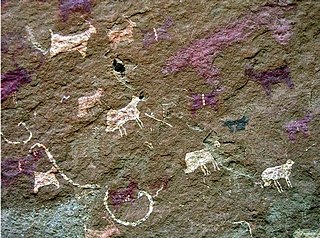
Dhambalin is an archaeological site in the central Sahil province of Somaliland. The sandstone rock shelter contains rock art depicting various animals such as horned cattle and goats, as well as giraffes, an animal no longer found in the country. The site also features the earliest known pictures of sheep in Somaliland. Discovered in autumn 2007, residents of Beenyo Dhaadheer reported the rock art to the Somali archaeologist Sada Mire, Director of the Department of Archaeology within the Ministry of Tourism and Culture of Somaliland.

Somaliland has many caves, some of which remain undiscovered. Such is the quality of the paintings that at least 10 sites, scattered across semi-desert terrain, are likely to be given World Heritage status.

